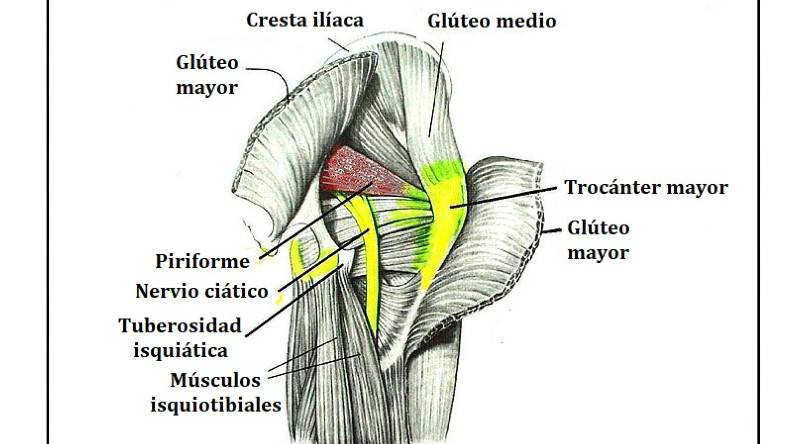If you’re an avid weightlifter, you know that proper form and technique are crucial for preventing injury and achieving your fitness goals. But what happens when an injury, like piriformis syndrome, disrupts your training?
Weightlifting with piriformis syndrome can be challenging, but it’s not impossible. In this article, we’ll cover everything you need to know about managing this condition while still lifting weights, including tips for modifying your routine, exercises for strengthening the piriformis muscle, and when to seek professional help. Let’s get started!

What is Piriformis Syndrome?
Piriformis syndrome is a condition that occurs when the piriformis muscle, which is located in the buttocks, becomes inflamed or tightened. This can lead to pain and discomfort in the buttocks, hips, and down the leg. Piriformis syndrome is also known as deep glute syndrome because the muscle is deep within the gluteal region.
The piriformis muscle is responsible for rotating the hip and leg outward, and it plays a key role in many lower body exercises, such as squats, deadlifts, and leg press. When the piriformis becomes inflamed or tightened, it can cause pain and discomfort, especially during these types of exercises. The pain may also be felt when sitting for long periods of time or when walking up stairs.
Piriformis syndrome is often caused by overuse, strain, or injury to the muscle. It can also be caused by poor posture or imbalances in the muscles of the hip and leg. In some cases, piriformis syndrome may be related to underlying conditions such as sciatica or spinal stenosis.
Here are three symptoms of piriformis syndrome:
- Pain or discomfort in the buttocks: People with piriformis syndrome may experience pain or discomfort in the buttocks area, especially when sitting for long periods of time or when performing certain lower body exercises.
- Pain or numbness down the leg: Piriformis syndrome can cause pain or numbness to radiate down the leg, often towards the back of the thigh or towards the foot.
- Difficulty walking or climbing stairs: The pain and discomfort associated with piriformis syndrome can make it difficult to walk or climb stairs, especially if the muscle is tightened or inflamed.
How Does Piriformis Syndrome Affect Weightlifting?
Here are the five ways in which piriformis syndrome can affect your weightlifting routine:
- Pain and discomfort during lower body exercises: Piriformis syndrome can cause pain and discomfort in the buttocks, hips, and down the leg, which can make it difficult to perform lower body exercises like squats, deadlifts, and leg press.
- Difficulty maintaining proper form: The pain and discomfort associated with piriformis syndrome can make it difficult to maintain proper form and technique during weightlifting exercises, which can increase the risk of injury.
- Limited range of motion: Inflammation or tightness in the piriformis muscle can limit your range of motion, making it harder to perform certain exercises or reach full depth in squats, for example.
- Decreased strength and power: Piriformis syndrome can cause weakness in the hip and leg muscles, which can lead to a decrease in strength and power during weightlifting exercises.
- Difficulty with balance and stability: The piriformis muscle plays a key role in maintaining balance and stability during lower body exercises, so if it is inflamed or tight, it can be harder to stay balanced and stable during weightlifting.
Tips for Lifting Weights with Piriformis Syndrome
Lifting weights with piriformis syndrome can be challenging, but it’s not impossible. By following these tips, you can manage your condition and continue to work towards your fitness goals. Here are six ways to lift weights with piriformis syndrome:
- Use proper form and technique: Maintaining proper form and technique is crucial for preventing injury and ensuring that you get the most out of your weightlifting routine. Pay close attention to your form and technique, especially when performing exercises that involve the piriformis muscle, such as squats, deadlifts, and leg press.
- Stretch and warm up before lifting: Stretching and warming up before lifting can help reduce inflammation and tightness in the piriformis muscle, making it easier to lift weights.
- Use proper footwear: Wearing shoes with good support and cushioning can help reduce the strain on the piriformis muscle and reduce the risk of injury.
- Avoid high-impact exercises: High-impact exercises, such as running or jumping, can place extra strain on the piriformis muscle and exacerbate symptoms of piriformis syndrome. Consider substituting low-impact exercises, such as cycling or swimming, until your condition improves.
- Gradually increase weight and intensity: Gradually increasing weight and intensity can help your muscles adapt and reduce the risk of injury. Start with lighter weights and lower intensity, and gradually increase as your condition improves.
- Consult with a physical therapist or doctor: If you’re struggling to manage piriformis syndrome and lift weights, consider consulting with a physical therapist or doctor. They can provide specialized exercises and treatment recommendations to help alleviate your symptoms and improve muscle function.
Exercises to Strengthen the Piriformis Muscle
Here are a few pre-workout mobility drills that can help improve flexibility and mobility in the piriformis muscle:
- Leg swings: Stand with your feet hip-width apart and your hands on your hips. Shift your weight to one leg and swing the other leg forward and back, gradually increasing the range of motion as you warm up. Repeat on the other side.
- Lateral lunges: Stand with your feet hip-width apart and your hands on your hips. Step to the side with your right foot and lower into a lunge, keeping your left leg straight. Push through your right heel to return to the starting position, then repeat on the other side.
- Fire hydrant circles: Start on all fours, with your hands under your shoulders and your knees under your hips. Lift your right leg out to the side, then circle it in a clockwise direction, keeping your foot flexed. Repeat in a counterclockwise direction, then repeat on the other side.
- Glute bridges: Lie on your back with your knees bent and your feet flat on the ground. Lift your hips off the ground and squeeze your glutes, then lower back down. Repeat for 10-15 reps.
After warming the muscles and joints of your hips and legs up, here are a few pre-workout stretches that can help reduce inflammation and tightness in the piriformis muscle:
- Seated piriformis stretch: Sit on the edge of a chair with your feet flat on the ground. Cross your left ankle over your right knee, then lean forward and hold the stretch for 30 seconds. Repeat on the other side.
- Standing piriformis stretch: Stand with your feet hip-width apart and your hands on your hips. Step your right foot behind you and bend your left knee, pushing your hips back and leaning your torso forward. Hold the stretch for 30 seconds, then repeat on the other side.
- Pigeon pose: Start on all fours, then bring your right ankle towards your left wrist and your right knee towards your right wrist. Lower your hips towards the ground and hold the stretch for 30 seconds. Repeat on the other side.
- Leg crossover stretch: Lie on your back with your arms at your sides. Cross your left ankle over your right knee, then lift your right foot off the ground and hold the stretch for 30 seconds. Repeat on the other side.
Remember to always stretch gently and never force your body into a position that feels uncomfortable or painful.
Here are a few exercises that can help strengthen the piriformis muscle and alleviate piriformis syndrome:
- Clamshells: Lie on your side with your hips and knees bent and your feet together. Lift your top leg up and down, keeping your feet together and your hips facing forward. Repeat for 10-15 reps, then switch sides.
- Side-lying leg raises: Lie on your side with your hips and knees bent and your feet together. Lift your top leg up and down, keeping your foot flexed and your hips facing forward. Repeat for 10-15 reps, then switch sides.
- Fire hydrant lifts: Start on all fours, with your hands under your shoulders and your knees under your hips. Lift your right leg out to the side, keeping your foot flexed and your hips facing forward. Lower back down, then repeat for 10-15 reps. Switch sides and repeat.
- Hip abduction: Stand with your feet hip-width apart and your hands on your hips. Lift your right leg out to the side, keeping your foot flexed and your hips facing forward. Lower back down, then repeat for 10-15 reps. Switch sides and repeat.
Performing mobility drills, stretches, and strengthening exercises before your leg day workout can be a great foundation for a safe and effective workout. These exercises can help improve flexibility, mobility, and strength in the piriformis muscle and other lower body muscles, which can help reduce the risk of injury and improve your performance during leg day exercises.
By incorporating these pre-workout exercises into your leg day routine, you can set yourself up for success and ensure that you get the most out of your workout.
Remember to start slowly and gradually increase the intensity as you progress, and always listen to your body and stop if you feel any pain or discomfort. If you have any questions about these exercises, or if you’re not sure which exercises are appropriate for you, consider consulting with a physical therapist or doctor.
Seeking Professional Help: When to Consult a Physical Therapist or Doctor for Piriformis Syndrome and Weightlifting
Congratulations on making it through this guide on lifting weights with piriformis pain! Managing piriformis syndrome can be challenging, but by following the tips and techniques outlined in this blog post, you can stay strong and continue to make progress in your fitness journey.
Remember to listen to your body and adjust your workouts as needed. If the exercises we have set out don’t work for you, then you should seek additional support from a physical therapist. Keep up the hard work and determination, and you will be well on your way to overcoming piriformis syndrome and reaching your strength and fitness goals.

